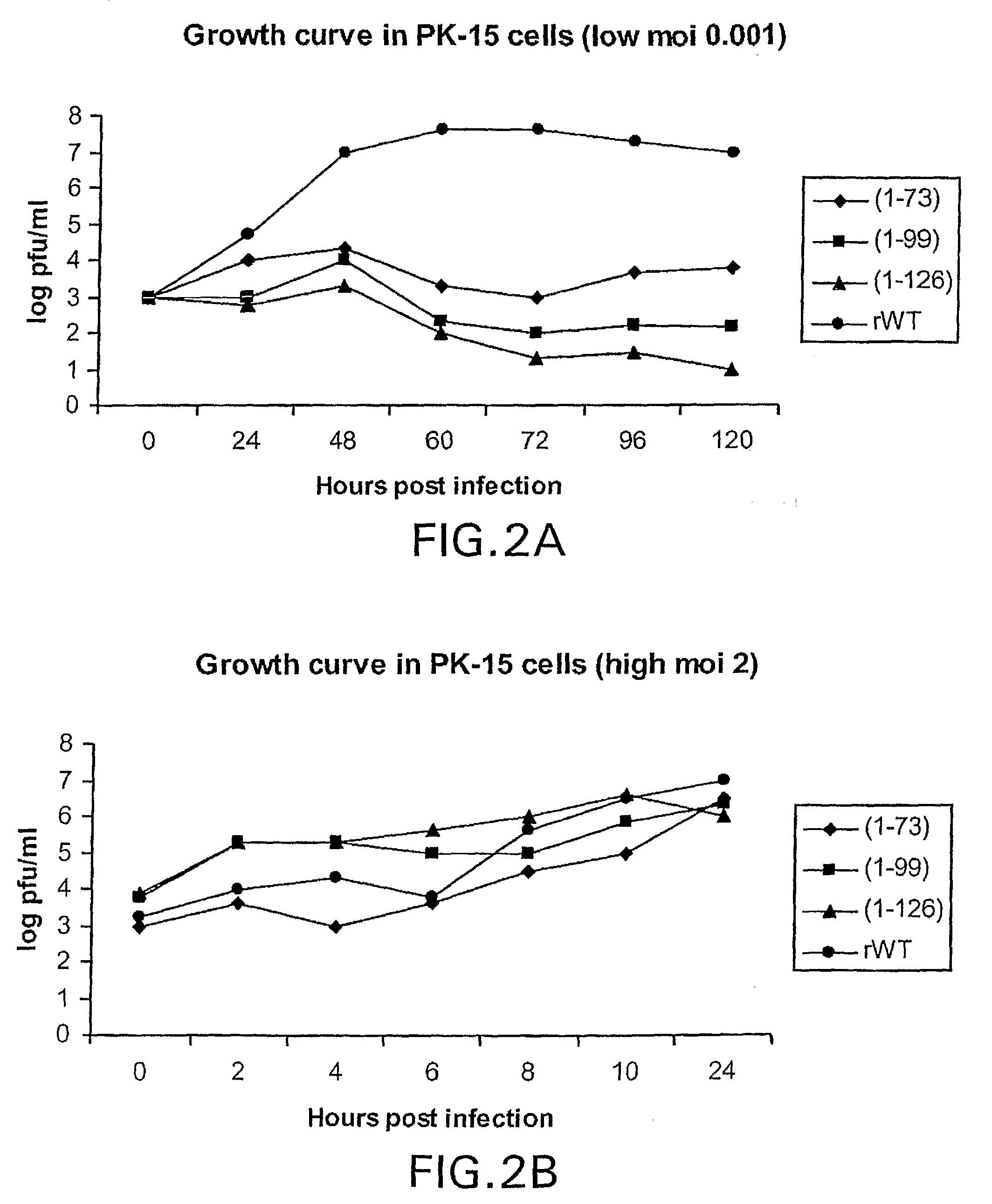Genetically engineered swine influenza virus and uses thereof
a technology of swine influenza virus and swine flu, which is applied in the field of attenuated swine influenza viruses, can solve the problems of ineffective replication, impaired ability of recombinant swine influenza viruses to inhibit ifn production in vitro, and antagonize such a response, so as to reduce viral titers, improve virulence, and improve the effect of virulen
- Summary
- Abstract
- Description
- Claims
- Application Information
AI Technical Summary
Benefits of technology
Problems solved by technology
Method used
Image
Examples
example 1
6.1 Example 1
Generation of Plasmid-Derived Sw / Tx98 Viruses Encoding Truncated NS1
[0246]Site directed mutagenesis was used to generate different deletions in the swine influenza virus NS segment in such a way that the NEP was expressed without any alteration while the NS1 was partially deleted. This was achieved by inserting a stop codon in the NS1 ORF followed by a deletion in the NS1 ORF encompassing nucleotides not involved in NEP expression.
[0247]Cells and Viruses. Pig kidney-15 (PK-15), Swine Testis (ST) and Madin-Darby canine kidney (MDCK) type II cells were grown in minimal essential medium (MEM) supplemented with 10% fetal bovine serum (FBS). Baby hamster kidney (BHK), 293T and A549 cells were grown in DMEM with 10% FBS. All cells were maintained at 37° C. and 5% CO2. The A / Swine / Texas / 4199-2 / 98 (TX / 98, H3N2 subtype) influenza virus was obtained from the repository at St. Jude Children's Research Hospital, Memphis, Tenn. Influenza viruses were grown in the allantoic cavities ...
example 2
6.2 Example 2
Characterization of the Swine Influenza Virus NS1 Deletion Mutants and Wild Type A / Swine / Texas / 4199-2 / 98
[0258]To characterize the impact of the NS1 gene deletion on the replicative properties of swine influenza virus, the growth of the wild-type and the different deletion mutants described in Section 6.1 was compared. Also, the effect of these mutants on IFN production was compared.
[0259]Virus growth curves. To analyze viral replication, confluent PK-15 cells were infected at the indicated multiplicity of infection (MOI) and incubated for different periods of times at 37° C. in MEM containing 0.3% bovine albumin (MEM / BA) and 5% allantoic fluid. Virus titers were determined by plaque assay on MDCK cells in MEM / BA supplemented with 1 μg / ml of TPCK trypsin. Titers were expressed as plaque forming units (PFU) per ml.
[0260]In order to investigate the multicycle growth properties of the mutant NS1 viruses confluent pig epithelial cells (PK-15) were infected at a low MOI (MOI=...
example 3
6.3 Example 3
Pathogenesis of Plasmid-Derived TX / 98 Mutant / Deletion Viruses
[0267]Pathogenesis of the specific swine influenza viruses described in Section 6.1 were assessed in pigs. The ability of Sw / Tx / 98 / del126, Sw / Tx / 98 / del99, and Sw / Tx / 98 / del73 to induce lung lesions and cause infections in swine were determined and compared to the results obtained for a mock virus and the wild-type virus Sw / Tx / 98 wt. Lung lesions were assessed as the percentage of the healthy lung in which lesions occurred with an average of seven lobes of the lung being used for this determination. Viruses or the mock were administered as described in detail below and either nasal swabs or BALF were obtained during necropsy to determine virus burden five days post infection. Histopathologic evaluation was preformed. The nasal turbinates and trachea were examined for epithelial changes and subepithelial inflammation. The alveoli were also evaluated for inflammatory changes.
[0268]This example demonstrates that C-...
PUM
| Property | Measurement | Unit |
|---|---|---|
| rectal temperature | aaaaa | aaaaa |
| polarity | aaaaa | aaaaa |
| width | aaaaa | aaaaa |
Abstract
Description
Claims
Application Information
 Login to View More
Login to View More - R&D
- Intellectual Property
- Life Sciences
- Materials
- Tech Scout
- Unparalleled Data Quality
- Higher Quality Content
- 60% Fewer Hallucinations
Browse by: Latest US Patents, China's latest patents, Technical Efficacy Thesaurus, Application Domain, Technology Topic, Popular Technical Reports.
© 2025 PatSnap. All rights reserved.Legal|Privacy policy|Modern Slavery Act Transparency Statement|Sitemap|About US| Contact US: help@patsnap.com



